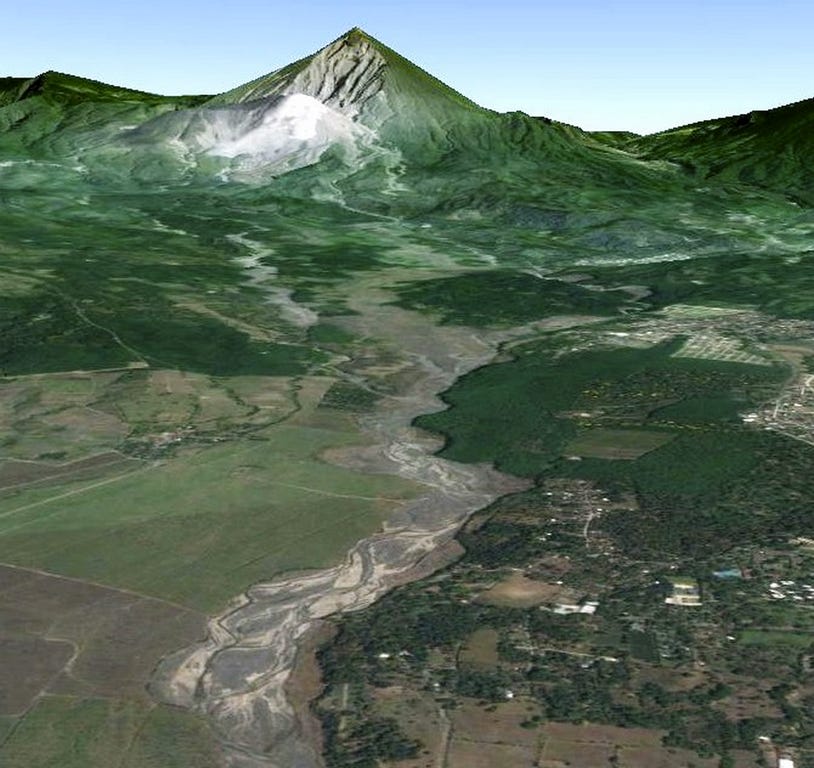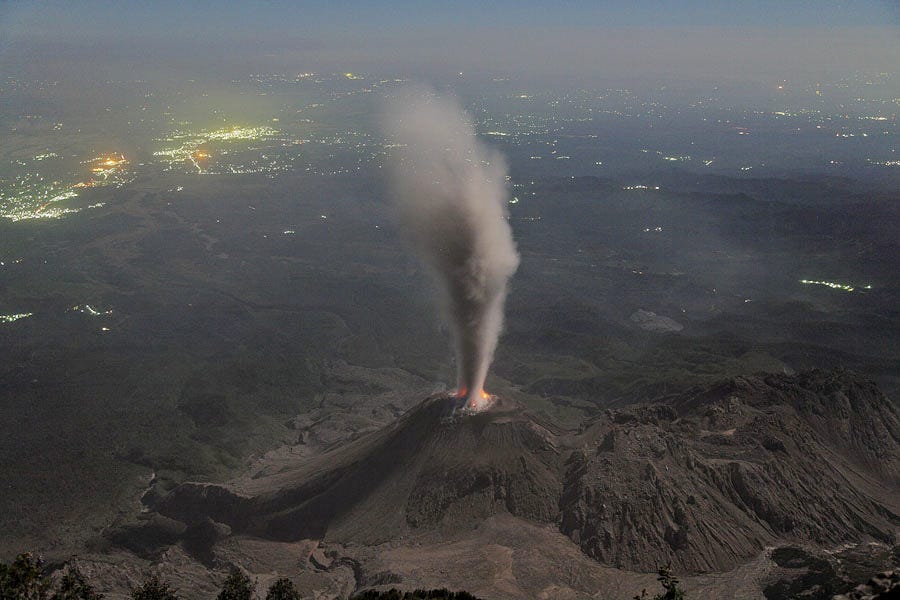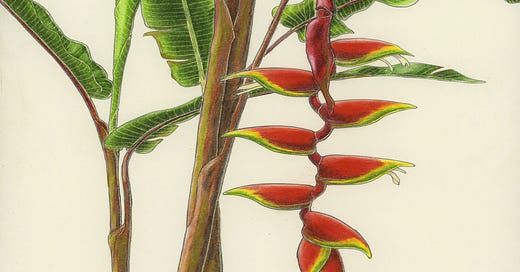My brother lived in Guatemala, a country whose eastern part is a low, level limestone platform that extends into Yucatan, Mexico, and was once home to a spectacular Mayan civilization, since returned to the jungle. The western side of Guatemala is a chain of volcanoes created when the Cocos plate rammed under the continental platform. From my brother's house in Antigua, the old colonial capital, you could see three volcanoes, Fuego, Agua and Acatenango. Fuego was nicely framed by the large Heliconia next to his house, and every morning we watched the mountain steaming steadily as we drank our coffee and the hummingbirds sipped Heliconia nectar.
The Spanish were pretty slow to realize that building their capital in the shadows of three active, smoking volcanoes might not be optimal. In 1541, a hot mudslide from Volcan Agua destroyed the capital and killed most of its inhabitants, forcing the Spanish to move it several miles to the present-day Antigua. Actually, that was already the second move, but they weren't out of the woods yet. Because their knowledge of subduction zones and plate tectonics was pretty sketchy, the Spanish were surprised each of the three- or four-times Antigua was destroyed by earthquakes. You might say, nobody expects the Spanish inquisition, least of all the Spanish.

After a few years, my brother moved his family to Retalhuleu, a town that no one has ever heard of on the back side of nowhere on the Pacific coastal plain, connected by narrow two-lane roads that are constantly in need of repair. It’s a region of endless sugar cane fields that produce mountains of sugar for export, alongside millions of bales of natural rubber. Down the street in the “colonia” where he now lived grew several champac trees, a kind of magnolia whose scent was enchanting. He still grew a couple of Heliconia, but they no longer framed a view of a steaming Volcan Fuego because the volcano was now out of sight. Whew! you would think, safe from the volcanic threat.

But no! The Samala’ River that runs past the town drains straight off the Volcan Santa Maria whose west side blew out in 1902 in one of the world's largest volcanic eruptions in 200 years, sending a mountain's worth of magma and debris thundering down onto the Pacific slope, killing 5000 people. Once she calmed down, Sta. Maria had a baby, Santiagito, a brand-new volcano that popped up on her scarred, collapsed western slope.

In 2011, Santiagito spewed ash and lava bombs and generated a lahar that threatened Retalhuleu. A warning to all towns downstream went out by radio, and residents of Retalhuleu gathered along the Rio Samala’ to watch the show.

What is a lahar? you may ask. In principle, it is a landslide lubricated by steam generated when molten lava contacts water. In practice, a large lahar is beyond scary, with a few cubic kilometers of hot debris lofted on steam to form a fluid that thunders down river valleys at about 200 miles an hour. Your chances of surviving a lahar are less than zero. In 2011, Retalhuleu was far enough downstream that "all they got" was a steaming flood that almost wiped out the only bridge across the River Samala’, threatening to cut off the town from the rest of the country.
Bridges over streams that drain the volcanoes to the Pacific were built with an original 50 ft. clearance, but the huge volumes of debris that continually wash down the streams has reduced the clearance so much that almost any high water threatens the bridges.
This was one of the reasons the Pan-American highway was routed through the high mountains rather than the level Pacific Plains (you would think this was contrary to engineering sense). The downside of the Pacific Plain was that earth moving machines work year-round to deepen the channel under the precious bridge that links Retalhuleu to the rest of the country, lest the bridge be swept away in the next flood or lahar.

But it is a task fit for Sisyphus, for deposition in the channel is fast and constant--- volcanic deposits are inherently unstable and erodible and this is rainy country in which a single storm can dump 5 inches of rain, swelling streams to the bursting.
The trouble with living within striking distance of an active volcano is that you know what is going to happen, you just don't know when. The Heliconia and champac can be enjoyed while you wait.




I read this as the windc chimes delicately sang outside the window and the autumn rains began to drum on the roof. The first paragraph itself is poetry and a lot of the rest is in turns very funny, ironic and somewhat terrifying. (and as always, educational) As Daniel often says "Mother Nature bats last" {Please gather these wonderful newsletters into a book!)
Here in PDX I live between two recently active volcanoes: Mt. St Helens which exploded not that long ago, and the apparently dormant Mount Hood, which still has steaming vents near the top. Ash from St Helens covered our city when it erupted. It's hard to look north toward it without wondering what's going on underneath its shattered cone.